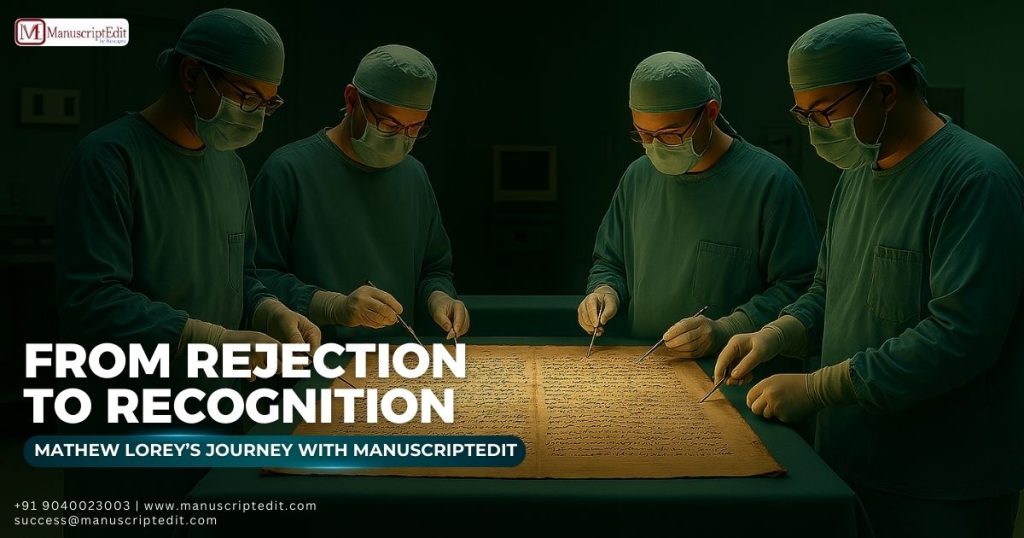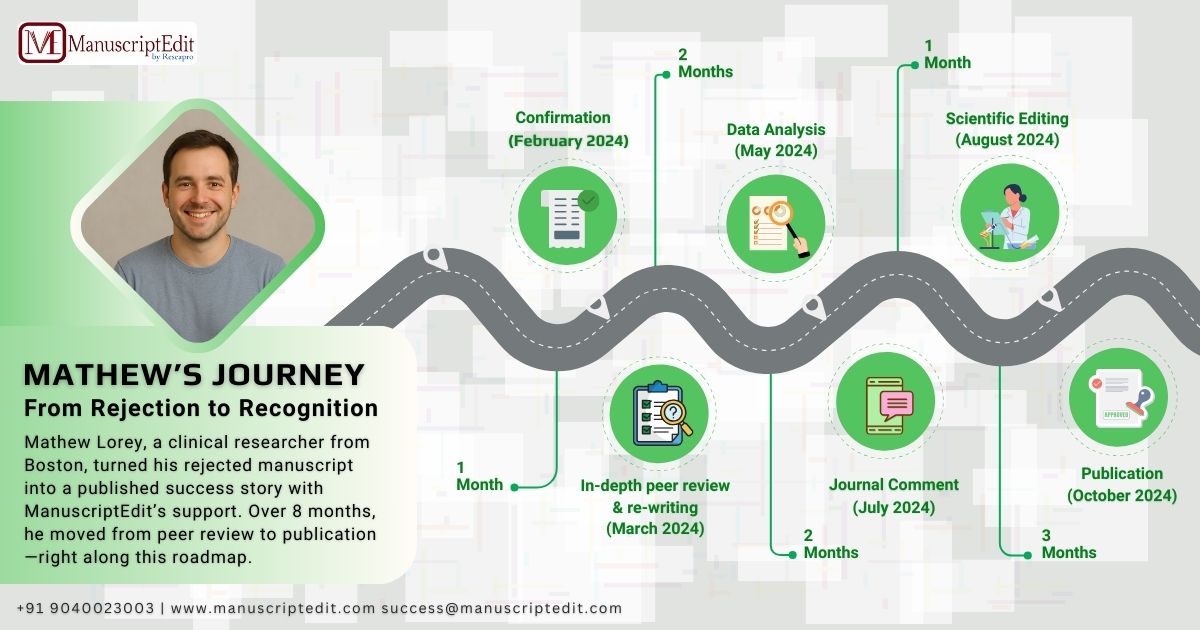|
Getting your Trinity Audio player ready...
|
In February 2024, a determined researcher named Mathew Lorey from Boston reached out to ManuscriptEdit. He spent three years on careful research to create a high-impact manuscript with strong methods and deep insight. His study explored a novel and high-risk subject: Laparoscopic Abdominal Surgery Under Thoracic Epidural Anaesthesia in Patients with Interstitial Lung Disease (ILD).

Traditionally, surgeons avoid performing laparoscopic abdominal surgery on ILD patients due to their compromised lung function. Mathew aimed to challenge this view. He believed his findings could help doctors manage these high-risk patients more safely and effectively.
Despite the study’s significance, five journals had already rejected the manuscript. One of those rejections came from Surgical Laparoscopy, Endoscopy & Percutaneous Techniques. The journal pointed out the lack of clinical impact and insufficient data as key issues. The repeated rejections left Mathew discouraged.
That’s when he contacted ManuscriptEdit for support.
Table of Contents
THE CHALLENGE
Upon reviewing the manuscript, ManuscriptEdit’s expert team quickly identified the primary issues holding the study back:
1. Poor interpretation and analysis of data
2. Poorly presented results
3. Scientific clarity affected by language concerns
4. Incomplete responses to previous reviewer comments
It was apparent the study had potential—it just required a more robust presentation.
THE TURNING POINT
Mathew opted for ManuscriptEdit’s comprehensive publication support package, which included:
• Advanced Statistical Analysis
• Scientific Writing & Rewriting
• Pre-submission Peer Review
• Reviewer Response Service
Here, ManuscriptEdit’s expert team got to work.
The Process
Step 1: In-depth Review and Rewriting
Expert editors rearranged the manuscript. They clarified the study’s purpose and clinical relevance, especially regarding how uncommon and applicable this surgical technique is to ILD patients.
Step 2: Improved Data Analysis
The statistical team employed more sophisticated equipment to make the results more robust. Complications, outcomes, and patient information were presented clearly and confidently.
Step 3: Reviewer Responses
Each previous reviewer’s comment was addressed carefully. The response was respectful, and the explanations were in-depth. This allowed editors and reviewers to view the changes quickly.
Reviewer 1 Comment:
“The manuscript lacks adequate statistical validation. Clinical significance is not well established. Further clarity in patient stratification and outcome metrics is necessary.”
Response:
Thank you for your valuable feedback. We have added multivariate statistical validation and clarified patient stratification based on ILD severity. Key outcome metrics—operative time, ICU stay, and pulmonary complications—have been defined and clearly presented in the revised Results section and Table 2 to support clinical relevance.
Reviewer 2 Comment:
“The structure is confusing, and the results section does not reflect a strong narrative. Data presentation needs overhaul.”
Response:
We appreciate this observation. The manuscript has been restructured using the standard IMRaD format. The Results section now follows a logical progression, supported by improved tables and figures to enhance clarity and narrative strength.

4. High-Impact Scientific Editing
The manuscript was extensively edited for clarity, accuracy, and scientific tone. The language was polished, and the formatting conformed to journal standards.
Mathew stayed actively engaged with ongoing updates and comments, enhancing the manuscript’s quality and his confidence.
The Result
The revised paper was resubmitted to Surgical Laparoscopy, Endoscopy & Percutaneous Techniques—the same journal previously rejected it.
After one month of review, Mathew got the acceptance letter he had been waiting for. The journal gave him ten days to check the galley proof, and then his paper was published in the next issue.
The paper was published and accepted in October 2024 in the leading journal: Surgical Laparoscopy, Endoscopy & Percutaneous Techniques.
The Takeaway
Rejection does not have to be the end, as Mathew Lorey’s story tells us. It’s usually the beginning of something greater. His persistence, coupled with ManuscriptEdit’s professional assistance, made disappointment turn into success.
This case reminds all researchers worldwide that good science merits good presentation. With appropriate support, even the most difficult journey can lead to publication.
Why Select ManuscriptEdit’s Reviewer Response & Peer Review Services?
Response to Reviewers Service Includes:
• Skillfully written, scientifically sound replies.
• Polite and logical responses.
• Journal-specific formatting and compliance.
• Timely support to avoid unnecessary delays.
Pre-Submission & Peer Review Services Offer:
• In-depth expert feedback.
• Identification of technical gaps.
• Risk minimization for rejections.
• Manuscript optimization before submission.
If your paper has been rejected more than once, don’t give up—there’s still a definite route to journal publication. Sometimes, it might need the proper guidance to change things for the better.
Here at ManuscriptEdit, we know how overwhelming the process can seem. That’s why our Journal Publication Support Packages and custom individual services are crafted to walk you through every step —from intense editing and professional peer review to writing persuasive responses and ultimate submission.
When you feel stuck or uncertain, we’re here to propel you forward—with confidence. Your research must need to be published. Allow us to assist you in making that a reality.



